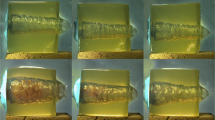Abstract
After contact shots to the head, biological traces can be found inside the barrel of the firearm. Experimental protocols to generate this sort of staining, using 12 cm gelatin cubes containing thin foil bags filled with acrylic paint, human blood, and radiocontrast agent, have been developed. Previous research on shots fired at a distance has shown the underlay sustaining these gelatin cubes has an influence on experimental results. This study was conducted to investigate the role of the sustaining base of the gelatin blocks during contact shots, and its influence on the staining result inside firearm barrels. Eighteen contact shots were performed using 22 LR, 32 ACP (7.65 Browning) and 9 mm Luger semi-automatic pistols. With each pistol, shots were fired onto six gelatin cubes; three placed upon a rigid platform and three upon an elastic underlay. The shots were recorded by a high-speed video camera as they penetrated the gelatin cube. Any staining present inside the firearm barrels after the shots were fired was documented by endoscopy. Cross sections of the gelatin blocks were then compared to the high-speed video. It was found that the nature of the staining inside the barrel was not influenced by the underlay sustaining the target model. In the experiment using a 9 mm Luger, the rigid counterfort provoked a visible distortion of the temporary cavity, but, cross sectional analysis of the gelatin cubes did not reveal a relevant influence of the sustaining underlay on the crack length in the gelatin. This could be explained by a secondary expansion of the temporary cavity left by the projectile as a consequence of subsequent inflow of muzzle gases.






Similar content being viewed by others
References
Schyma C, Brünig J, Madea B, Jackowski C. Die Endoskopie des Waffenlaufes. Rechtsmedizin. 2016;26:224–9.
Schyma C, Bauer K, Brünig J, Courts C, Madea B. Staining in firearm barrels after experimental contact shots. Forensic Sci Int. 2017;273:64–70.
Schyma C, Madea B, Courts C. Persistence of biological traces in gun barrels after fatal contact shots. Forensic Sci Int Genet. 2013;7:22–7.
Grabmüller M, Schyma C, Euteneuer J, Madea B, Courts C. Simultaneous analysis of nuclear and mitochondrial DNA, mRNA and miRNA from backspatter from inside parts of firearms generated by shots at "triple contrast" doped ballistic models. Forensic Sci Med Pathol. 2015;11:365–75.
Courts C, Madea B, Schyma C. Persistence of biological traces in gun barrels – an approach to an experimental model. Int J Legal Med. 2012;126:391–7.
Schyma C, Lux C, Madea B, Courts C. The 'triple contrast' method in experimental wound ballistics and backspatter analysis. Int J Legal Med. 2015;129:1027–33.
Schyma C, Bauer K, Brünig J. The reference cube: a new ballistic model to generate staining in firearm barrels. Forensic Sci Med Pathol. 2017;13:188–95.
Schyma C, Herr N, Brünig J, Brenčičová E, Müller R. The influence of the counterfort while ballistic testing using gelatine blocks. Int J Legal Med. 2017;131:1325–32.
Schyma C, Madea B. Evaluation of the temporary cavity in ordnance gelatine. Forensic Sci Int. 2012;214:82–7.
Regneri W. Diagnostik bei Suizid mit Schusswaffen. Endoskopie von Waffenläufen und DNA-Analyse als komplementäre Methoden. Dissertation, Universität des Saarlandes, Homburg. 2006.
Brüning A, Wiethold F. Die Untersuchung und Beurteilung von Selbstmörderschusswaffen. Dtsch Z Gerichtl Med. 1934;23:71–82.
Betz P, Peschel O, Stiefel D, Eisenmenger W. Frequency of blood spatters on the shooting hand and of conjunctival petechiae following suicidal gunshots wounds to the head. Forensic Sci Int. 1995;76:47–53.
Karger B, Nüsse R, Schroeder G, Wüstenbecker S, Brinkmann B. Backspatter from experimental close-range shots to the head. I. Macrobackspatter. Int J Legal Med. 1996;109:66–74.
Davidson PL, Taylor MC, Wilson SJ, Walsh KA, Kieser JA. Physical components of soft-tissue ballistic wounding and their involvement in the generation of blood backspatter. J Forensic Sci. 2012;57:1339–42.
Kneubuehl BP. Simulants. In: Kneubuehl BP, Coupland RM, Rothschild MA, Thali MJ, editors. Wound ballistics: basics and applications. Berlin: Springer; 2011. p. 136–51.
GroßePerdekamp M, Glardon M, Kneubuehl BP, Bielefeld L, Nadjem H, Pollak S, et al. Fatal contact shot to the chest caused by the gas jet from a muzzle-loading pistol discharging only black powder and no bullet: case study and experimental simulation of the wounding effect. Int J Legal Med. 2015;129:125–31.
Schyma C, Bauer K, Brünig J, Schwendener N, Müller R. Visualization of the powder pocket and its influence on staining in firearm barrels in experimental contact shots. Int J Legal Med. 2017;131:167–72.
Acknowledgments
The expert technical assistance of Nicole Schwendener (Bern) is gratefully acknowledged.
Funding
This research work was funded by the SNF (Swiss National Science Foundation, project 310030E-147628 / 1).
Author information
Authors and Affiliations
Corresponding author
Ethics declarations
Conflict of interest
The authors declare that they have no conflict of interests.
Ethical approval
All procedures performed in studies involving human participants were in accordance with the ethical standards of the institutional and/or national research committee and with the 1964 Helsinki declaration and its later amendments or comparable ethical standards.
Informed consent
Informed consent was obtained from all individual participants included in the study.
Electronic supplementary material
Online Resource 1
Endoscopic view of the posterior barrel part of the .22 LR pistol showing abundant staining up to the chamber. (GIF 136 kb)
Online Resource 2
Maximum TC in the reference cube placed on a sponge after a contact shot using the .22 LR HV non-deforming cartridge. (GIF 58 kb)
Online Resource 3
Endoscopic view of the barrel of the pistol cal. 9 mm Luger showing extended spray-like staining from the muzzle to the posterior half of the barrel. (GIF 175 kb)
Rights and permissions
About this article
Cite this article
Schyma, C., Müller, R., Brenčičová, E. et al. Distortion of the temporary cavity and its influence on staining in firearm barrels. Forensic Sci Med Pathol 14, 202–208 (2018). https://doi.org/10.1007/s12024-018-9971-0
Accepted:
Published:
Issue Date:
DOI: https://doi.org/10.1007/s12024-018-9971-0




